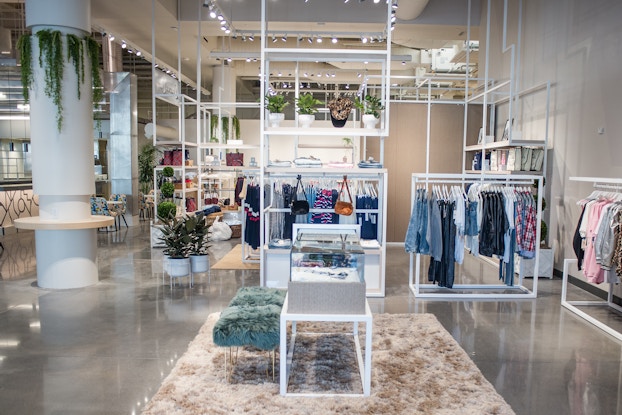
Playful isn’t a word that is necessarily top of mind when you think about shopping in a department store. Yet, Matt Alexander, CEO and co-founder of the two-year-old Neighborhood Goods, used it at least half a dozen times to describe everything from merchandising to customer service at Neighborhood Goods, a startup retailer that bills itself as “a new department store.”
Neighborhood Goods takes the traditional business model of gathering everything from housewares and apparel to beauty and gifts from a variety of brands — including a heavy mix of direct-to-consumer brands — and selling them under one roof, but gives it a modern twist.
For instance, instead of covering acres of real estate as an anchor mall tenant, its first location in Plano, Texas clocks in at around 14,000 square feet in an open-air, mixed-use development. Instead of carrying a mix of private label and recognizable brands, Neighborhood Goods is featuring a revolving roster of 30 to 40 upstart direct-to-consumer labels and celebrity lines such Serena Williams' new apparel collection. Instead of a swanky cafe for the ladies who lunch après shopping, the Plano location has Prim and Proper, a “collaborative concept” in partnership with local hospitality group Front Burner Restaurants. There are regular chances to meet your “neighbors” (store staff, other customers and business owners) at events tied to the community, such as live music or barre classes. There’s an app to facilitate self-checkout in the store, or you can order select items online.
Now in expansion mode, the startup recently closed a second round of funding, which brings the total it has received to $14.5 million, and has set plans to open five more locations, including a New York City store later this year.
We think of location as being something that just serves a real purpose for these brands in a very playful way.Matt Alexander, CEO, Neighborhood Goods
Make the Shift
Neighborhood Goods provides a brick-and-mortar opportunity for direct-to-consumer upstarts. Considering shifting your e-commerce business to physical retail? Read more here.
Curating experimental retail spaces
Alexander has been in the business of experimental retail and curated spaces for the last six years. And Neighborhood Goods is informed by his playful approach to merchandising.
As a serial entrepreneur, Alexander launched a curated menswear e-commerce site called Edition Collective as well as Unbranded, a nonprofit space for local artists, chefs and other creatives to show and sell their work. In between, Edition Collective was acquired by Q Fifty One, a Dallas-based merchant with brick-and-mortar stores across the southwest, and Alexander was tapped to lead its digital sales efforts.
All these experiences (some occurring simultaneously) made it clear to Alexander that retail wasn’t dead, it was just ripe for a makeover that would delight customers by giving them a chance to discover emerging brands they might not otherwise know about.
This comes at a time when digitally native brands are pushing to have a presence in the brick-and-mortar landscape. Startups from eyewear manufacturer Warby Parker to mattress purveyor Casper to menswear brand Bonobos are investing in physical locations from malls to pop-up shops. Direct-to-consumer (DTC) brands are set to open 850 stores in the next five years, according to a report on over 100 top online retailers from commercial real estate firm JLL.
The reason they’re scrambling, according to Alexander, is that e-commerce alone isn’t growing at a pace to keep up with the cost of keeping customers coming back to buy. “Physical retail has been identified as a potential solution because [those customers] tend to have five times the lifetime value of a customer acquired online,” he told CO—. It’s also due to four consecutive quarters of slowing online sales growth that is expected to keep slowing, according to data from FTI Consulting's U.S. Online Retail Forecast.
That said, Alexander doesn’t want to focus on metrics. He didn’t divulge any revenue numbers, nor was he willing to discuss the split between digital and physical sales. “It’s all very blended,” he confessed. For both Neighborhood Goods and the brands it carries, “We wanted to approach it from a relatively almost naive and optimistic perspective,” Alexander said, “creating a physical retail space that isn't necessarily focused on transactions where the core metric isn't necessarily sales per square foot.” He explained that Neighborhood Goods is building a “meaningful platform” for DTC brands that want to experiment with physical retail but don’t necessarily have the resources to gamble with signing a standard 10-year lease.
Jill Standish, senior managing director and head of retail at Accenture, said, “Where previously brands have had to add to their skills as a retailer, in Neighborhood Goods’ case, the model is more collaborative and the focus isn’t on who’s responsible for the markdown, it’s a question of how to most effectively work together to sell the products.” Standish believes the retail industry needs more of this, as well as more focus on customer service and experience.

Taking a shot at reviving an old-school retail model
Of course, Neighborhood Goods isn’t the first to try to reinvent the department store experience.
Story, which Macy’s acquired, blends the pop-up and department store models by showcasing goods around changing central themes. Dover Street Market, in major cities like Los Angeles and Singapore, and Forty Five Ten in Miami and neighboring Dallas, among other locations, have also looked to shake up the model.
Alexander contends that there are elements that set Neighborhood Goods apart. “We are trying to really hold ourselves to a very specific account about prioritizing a really positive and dignified and ethical experience above all else,” he said. Part of that is paying its store staff more than the industry average and not on commission. “It's structured more around allowing these people to come in and be focused more on hospitality and storytelling than having a real race to the bottom in terms of trying to meet sales quotas and cheapening the experience,” Alexander said.
Another critical element of the business is finding out why the brands want to get into physical retail, Alexander explained. Their goals range from exploring customer demographics to being showcased alongside particular events. Brands are tasked with keeping their products and displays fresh and interesting for everyone. Some need more help than others to meet their goals, he said.
“We think of location as being something that just serves a real purpose for these brands in a very playful way,” Alexander said, “So as we expand, each of these locations will have different formatting from one place to the next, to fit these different goals.”
This will be apparent when Neighborhood Goods opens its next store, a 4,500 square-foot space in Chelsea Market in New York City later this year.
Its second round of funding will help with signing leases and setting up stores across the country, Alexander said. He wouldn’t say where it was looking, but said Neighborhood Goods aims to set up shop “where we can be that discovery and delivery mechanism to an otherwise underserved customer, and to also help deliver brands into areas that they would love to be in but have not otherwise have access. So we get to play very much in that space.”
Sucharita Kodali, vice president, principal analyst at Forrester maintained that traditional department stores still have broader reach with their physical presence and that will keep Neighborhood Goods from becoming the next big department store. She conceded that theirs is an interesting model that has potential for reasonable success. “It is a model that makes sense for others to emulate,” Kodali said, “that is essentially how most department stores in Europe operate anyway. Why it hasn’t been adopted more broadly in the U.S. is odd, but I expect that to change in the future.”
CO— aims to bring you inspiration from leading respected experts. However, before making any business decision, you should consult a professional who can advise you based on your individual situation.
CO—is committed to helping you start, run and grow your small business. Learn more about the benefits of small business membership in the U.S. Chamber of Commerce, here.








